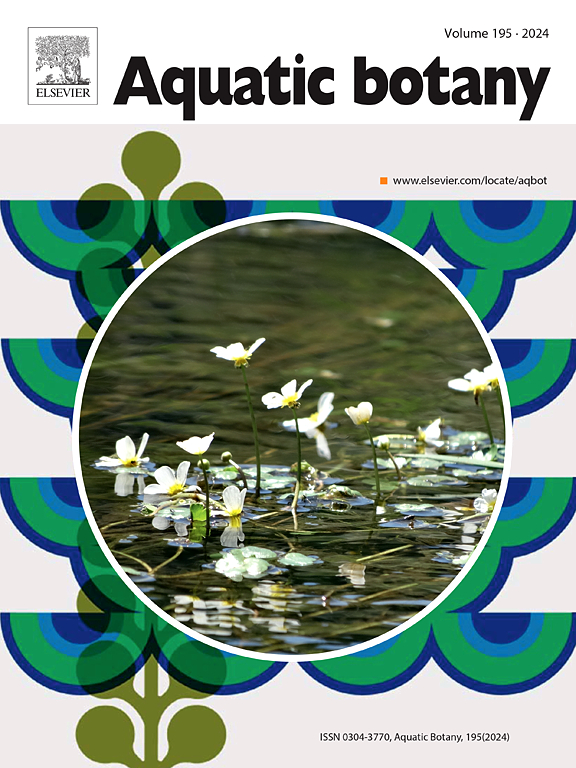Reproductive and recruitment potential of Halophila hawaiiana
IF 2.6
4区 生物学
Q2 MARINE & FRESHWATER BIOLOGY
引用次数: 0
Abstract
Understanding the details of seagrass species’ vegetative and sexual reproductive capacity is important to inform restoration efforts for these habitat engineers. Previous work has shown that vegetative fragments of Halophila species can settle and establish in new areas. However, it is unclear whether fragment size impacts vegetative reproduction success, and whether the isolated species Halophila hawaiiana has retained this ability. To determine whether H. hawaiiana can settle and establish from vegetative fragments, we took fragments of various sizes and fixed them to a string held just above the sediment in situ. We found that fragments could settle and establish into the sediment; 39 % of fragments grew roots into the sediment by day 14. Fragment settlement was strongly associated with month and location. Fragment size non-linearly influenced fragment settlement, with medium-sized fragments (four to six nodes) being the most successful. Regarding sexual reproduction for H. hawaiiana, observed seeds have previously been considered a result of apomixis; however, the presence of staminate flowers indicates that sexual reproduction may be possible. We collected flowers and artificially pollinated them in the lab, with unpollinated flowers isolated as a control. Endosperm growth and seed production was observed in the treatment group but not the control - suggesting sexual reproduction and not apomixis is the method of seed production for this species. To guide seagrass conservation efforts, future research is needed to understand the links between vegetative fragment settlement and patch expansion, and to determine environmental factors that induce flowering and seed germination in H. hawaiiana.
夏威夷嗜盐菌的繁殖和招募潜力
了解海草物种的营养和有性生殖能力的细节对这些栖息地工程师的恢复工作至关重要。先前的研究表明,嗜盐菌的营养碎片可以在新的地区定居和建立。然而,尚不清楚碎片大小是否影响营养繁殖的成功,以及分离物种夏威夷盐嗜菌是否保留了这种能力。为了确定夏威夷人是否可以从植物碎片中定居和建立,我们取了各种大小的碎片,并将它们固定在原位沉积物上方的一根绳子上。我们发现碎片可以沉淀并进入沉积物;39 %的碎片在第14天生根进入沉积物。碎片沉降与月份和地点密切相关。碎片大小非线性地影响碎片的沉降,中等大小的碎片(四到六个节点)是最成功的。关于夏威夷人的有性生殖,以前观察到的种子被认为是无融合的结果;然而,雄蕊花的存在表明有性繁殖是可能的。我们收集花并在实验室里人工授粉,将未授粉的花隔离作为对照。在处理组观察到胚乳的生长和种子的产生,而在对照组则没有,这表明该物种的种子产生方式是有性生殖而不是无融合生殖。为了指导海草的保护工作,未来的研究需要了解营养碎片沉降与斑块扩展之间的联系,并确定诱导夏威夷海草开花和种子萌发的环境因素。
本文章由计算机程序翻译,如有差异,请以英文原文为准。
求助全文
约1分钟内获得全文
求助全文
来源期刊

Aquatic Botany
生物-海洋与淡水生物学
CiteScore
3.80
自引率
5.60%
发文量
70
审稿时长
6 months
期刊介绍:
Aquatic Botany offers a platform for papers relevant to a broad international readership on fundamental and applied aspects of marine and freshwater macroscopic plants in a context of ecology or environmental biology. This includes molecular, biochemical and physiological aspects of macroscopic aquatic plants as well as the classification, structure, function, dynamics and ecological interactions in plant-dominated aquatic communities and ecosystems. It is an outlet for papers dealing with research on the consequences of disturbance and stressors (e.g. environmental fluctuations and climate change, pollution, grazing and pathogens), use and management of aquatic plants (plant production and decomposition, commercial harvest, plant control) and the conservation of aquatic plant communities (breeding, transplantation and restoration). Specialized publications on certain rare taxa or papers on aquatic macroscopic plants from under-represented regions in the world can also find their place, subject to editor evaluation. Studies on fungi or microalgae will remain outside the scope of Aquatic Botany.
 求助内容:
求助内容: 应助结果提醒方式:
应助结果提醒方式:


